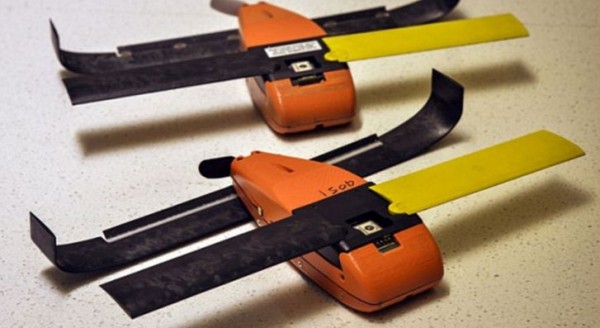US Air Force Perdix Aerial Microdrones are Ready for Prime Time on the Battlefield
| Arthur Dominic Villasanta | | Jan 10, 2017 04:46 AM EST |
(Photo : SCO) Perdix drones
The latest demonstration of the capabilities of the autonomous "Perdix" aerial microdrones to self-pilot and swarm brings these 3D printed and cheap drones closer to entering service with the U.S. military as aerial spies; radar jammers or killer drones armed with explosive warheads powerful enough to kill individual enemy soldiers.
Like Us on Facebook
Perdix is ready for prime time.
The test on Jan. 8 over Naval Air Station China Lake in California showed off Perdix's collective decision-making, adaptive formation flying and self-healing abilities without human intervention, said the U.S. Department of Defense.
During the demo, the Perdix drones collectively decided one mission had been accomplished. They then flew on to the next mission and carried out that one.
The benefit of a swarm is that if one drone or more crash or fail to deploy, the remainder can rearrange themselves to maintain coverage.
Perdix microdrones are ejected from flare dispensers of U.S. Air Force warplanes such as the General Dynamics F-16 and the McDonnell Douglas F/A-18 Hornet. They fall to earth, deploy their folded twin wings and assume a formation to attain the goal they're programmed to accomplish.
The drones can withstand ejection speeds reaching Mach 0.6 (740 km/h) and temperatures as low as minus 10 degrees Celsius. They can talk to each other to collaborate in accomplishing their missions. The Perdix drones operate in cooperative swarms of 20 or more, and work together towards a single goal.
One of the jobs of these drones is to confuse enemy radar systems, diverting attention away from manned air superiority fighters or attack jets. An F-16 has 30 flare dispensers and can, therefore, carry 30 Perdixes.
Perdixes are 3D-printed using Kevlar and carbon fiber. Each drone comes with spring-loaded carbon fiber wings; a low-drag fiberglass fuselage; a custom pusher propeller and a lithium polymer battery pack.
Each drone is about the size of an iPhone 6 and weighs some 2.2 kilograms. It's built using commercial off-the-shelf components.
The microdrone was created and developed by MIT students. The Pentagon's once secret Strategic Capabilities Office (SCO) liked the idea and repurposed a drone intended for civilian scientific experiments into a drone that fights wars.
SCO Director William Roper, a physicist, began Perdix testing in 2014. SCO's goal is to make the Perdix system much more effective and more cost-friendly compared to the expensive and very much larger ADM-160 MALD (Miniature Air-Launched Decoy). MALD is 2.4 meters long.
"They (Perdixes) are expendable and fly low as a surveillance asset. You can have a lot of them for a saturation approach. Saturating has an advantage over the thing it has to defend against. Its defender has to take more time and money to defend against it," said Roper.
The Defense Department agrees.
"Just imagine an airplane going in against an IAD (Integrated Air Defense) system and dropping 30 of these out that form into a network and do crazy things," said Robert Work, Deputy Secretary of Defense.
"We've tested this. We've tested it and it works."
The Pentagon has been testing swarms of drones designed to jam enemy air defenses; blanket areas with small sensors and attack targets.
TagsPerdix aerial microdrones, 3D printed, U.S. Air Force, General Dynamics F-16, McDonnell Douglas F/A-18 Hornet
©2015 Chinatopix All rights reserved. Do not reproduce without permission
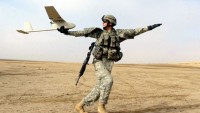 Ukraine Blasts US for Supplying it with Obsolete Aerial Drones
Ukraine Blasts US for Supplying it with Obsolete Aerial Drones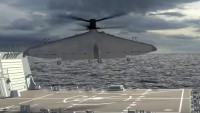 Over 100 US Navy Warships to become Aircraft Carriers with Deployment of TERN Aerial Drone
Over 100 US Navy Warships to become Aircraft Carriers with Deployment of TERN Aerial Drone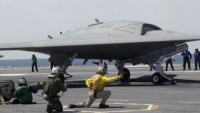 US Navy’s First Carrier Aerial Drone Morphs into Multi-mission Aircraft
US Navy’s First Carrier Aerial Drone Morphs into Multi-mission Aircraft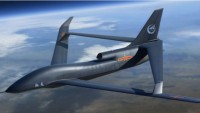 Oddly Winged Xianglong Aerial Drone to Guide Chinese Missiles to US Navy Warships
Oddly Winged Xianglong Aerial Drone to Guide Chinese Missiles to US Navy Warships
EDITOR'S PICKS
-

Did the Trump administration just announce plans for a trade war with ‘hostile’ China and Russia?
-

US Senate passes Taiwan travel bill slammed by China
-

As Yan Sihong’s family grieves, here are other Chinese students who went missing abroad. Some have never been found
-

Beijing blasts Western critics who ‘smear China’ with the term sharp power
-

China Envoy Seeks to Defuse Tensions With U.S. as a Trade War Brews
-

Singapore's Deputy PM Provides Bitcoin Vote of Confidence Amid China's Blanket Bans
-

China warns investors over risks in overseas virtual currency trading
-

Chinese government most trustworthy: survey
-

Kashima Antlers On Course For Back-To-Back Titles
MOST POPULAR
LATEST NEWS
Zhou Yongkang: China's Former Security Chief Sentenced to Life in Prison

China's former Chief of the Ministry of Public Security, Zhou Yongkang, has been given a life sentence after he was found guilty of abusing his office, bribery and deliberately ... Full Article
TRENDING STORY

China Pork Prices Expected to Stabilize As The Supplies Recover

Elephone P9000 Smartphone is now on Sale on Amazon India

There's a Big Chance Cliffhangers Won't Still Be Resolved When Grey's Anatomy Season 13 Returns

Supreme Court Ruled on Samsung vs Apple Dispute for Patent Infringement

Microsoft Surface Pro 5 Rumors and Release Date: What is the Latest?
